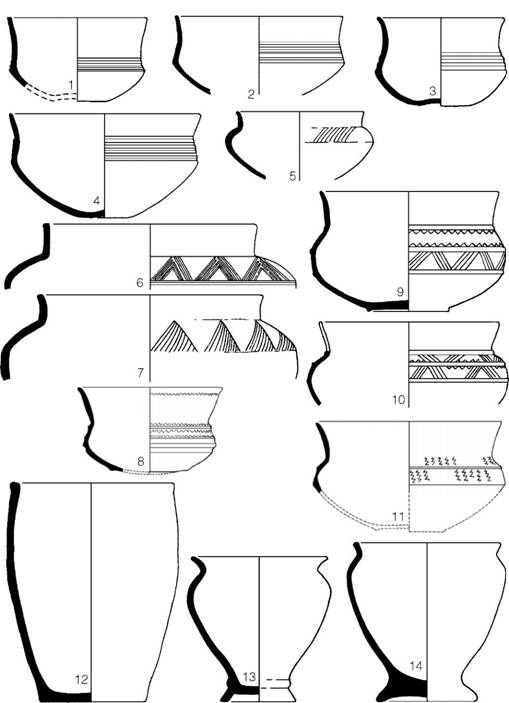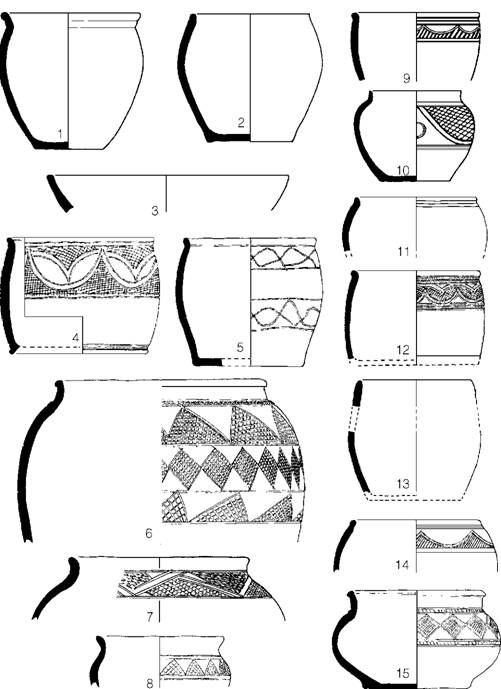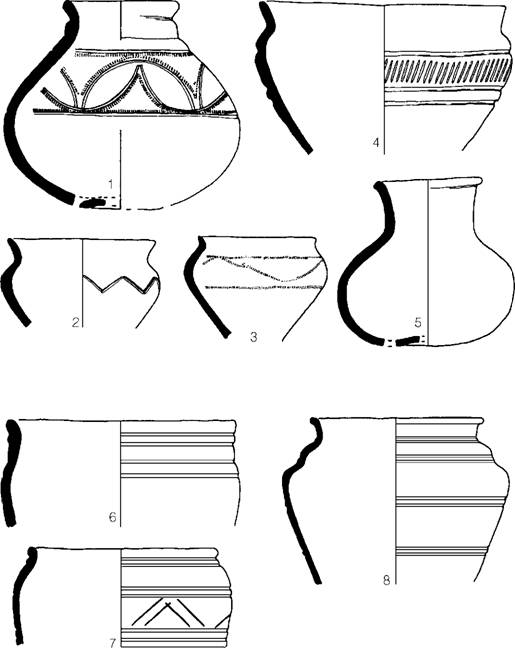Appendix A
Pottery
In several chapters, particularly 5, 8 and 9 it has been necessary to refer extensively to assemblages of pottery. Pottery is vitally important for the establishment of sequences, for the definition of regional groupings and for throwing some light on the complexities of commercial production and trade. For this reason we illustrate here a representative selection of the major groups. Where vessels have been drawn from the original material, the source is given as ‘author’; when they are drawn from published sources, the publication is cited. Reference to the site list (Appendix C) will, in the case of unpublished material, give the present location of the collections. All drawings are at quarter the original size.

Figure A:1 The Ultimate Deverel–Rimbury tradition: eleventh to ninth centuries. 1–5 Eldon’s Seat (Encombe), Dorset (source: Cunliffe 1968b).

Figure A:2 The Early All Cannings Cross group: ninth to eighth centuries. 1–11 All Cannings Cross, Wilts.; 12–14 Cold Kitchen Hill, Wilts. (source: author).

Figure A:3 The Kimmeridge-Caburn group: eighth to seventh centuries. 1-2 the Caburn, Sussex; 3-7 Kimmeridge, Dorset; 8–9 the Caburn, Sussex; 10 Hollingbury Camp, Sussex; 11 Kingston Buci, Sussex; 12–14 Kimmeridge, Dorset (source: author).

Figure A:4 The Highstead 2 group: eighth to sixth centuries. 1 Monkton Court Farm, Kent; 2–4 High- stead, Chislet, Kent; 5 Cobham Golf Course, Rochester, Kent; 6–7 Monkton Court Farm, Kent; 8 Highstead, Chislet, Kent; 9–11 Minnis Bay, Kent; 12 Highstead, Chislet, Kent (sources: 1–8 and 12 original drawings by Nigel Macpherson-Grant; 9–11 author).

Figure A:5 The West Harling–Fengate group: eighth to sixth centuries. 1–5 Fengate, Northants; 6–7 Little Bealings, Norfolk; 8 West Harling, Norfolk; 9 Creeting St Mary, Suffolk; 10–12 West Harling, Norfolk; 13 Buntley, Suffolk; 14 West Harling, Norfolk; 15 Cromer, Norfolk (sources: 6–7 Martin 1993; rest author).

Figure A:6 The Staple Howe group: eighth to sixth centuries. 1–9 Staple Howe, Yorks. (source: Brewster 1963).

Figure A:7 The Ivinghoe–Sandy group: eighth to sixth centuries. 1–4 Sandy, Beds.; 5 Chippenham, Cambs.; 6–8 Sandy, Beds.; 9–10 Green End Road, Cambs.; 11 Grantchester, Cambs.; 12–14 Kempston, Foster’s Pit, Beds.; 15 Totternhoe, Beds.; 16–18 Harrold, Beds. (source: author).

Figure A:8 The All Cannings Cross–Meon Hill group: fifth to third centuries. 1 Winchester, Hants; 2 Boscombe Down West, Wilts.; 3–4 All Cannings Cross, Wilts.; 5 Boscombe Down West, Wilts.; 6 All Cannings Cross, Wilts.; 7–8 Boscombe Down West, Wilts.; 9 Danebury, Hants; 10 All Cannings Cross, Wilts.; 11 Meon Hill, Hants; 12 Danebury, Hants; 13 Boscombe Down West, Wilts.; 14 Swallowcliffe, Wilts. (source: author).

Figure A:9 Dorset and Somerset variants of the All Cannings Cross–Meon Hill group: fifth to third centuries. 1—11 Eldon’s Seat, Dorset; 12–13 Pagan’s Hill, Somerset; 14–16 Bathampton Down, Somerset (sources: 1–11 Cunliffe 1968b; 12–16 author).

Figure A:10 The Park Brow–Caesar’s Camp group: fifth to third centuries. 1 St Catharine’s Hill, Guild- ford, Surrey; 2–3 Caesar’s Camp (Wimbledon), Surrey; 4 St Martha’s Hill, Surrey; 5 Chertsey, Surrey; 6 St George’s Hill (Weybridge), Surrey; 7–13 Park Brow, Sussex; 14 Muntham Court, Sussex (source: author).

Figure A:11 The Long Wittenham–Allen’s Pit group: fifth to third centuries. 1 Chinnor, Oxon.; 2–5 Long Wittenham, Oxon.; 6 Allen’s Pit, Oxon.; 7 Chinnor, Oxon.; 8 Mount Farm, Oxon.; 9 Long Wittenham, Oxon.; 10 Allen’s Pit, Oxon.; 11 Mount Farm, Oxon.; 12 Dennis Pit, Old Marden, Oxon.; 13 Bampton, Oxon.; 14 Witham, Berks. (source: author).

Figure A:12 The Chinnor–Wandlebury group: fifth to third centuries. 1–2 Bledlow, Bucks.; 3–5 Ellesbor- ough, Bucks.; 6–9 Great Wymondley, Herts.; 10–13 Chinnor, Oxon.; 14 Great Wymondley, Herts.; 15 Chinnor, Oxon.; 16–17 Wandlebury, Cambs.; 18 Abington Pigotts, Cambs.; 19–23 Blewburton, Berks.; 24 Chinnor, Oxon.; 25 Mortlake, Middlesex (source: author).

Figure A:13 The Darmsden-Linton group: fifth to third centuries. 1–5 Darmsden, Suffolk; 6–7 Linton, Cambs.; 8 Leigh Hill, Cobham, Surrey; 9 Linton, Cambs.; 10 Feltwell, Norfolk; 11 Leigh Hill, Cobham, Surrey; 12 Romford, Essex; 13–14 Darmsden, Suffolk; 15 Hawk’s Hill, Surrey; 16 Esher, Surrey; 17–18 Linton, Cambs.; 19–20 Hinderclay, Suffolk; 21 Linton, Cambs.; 22 Hinderclay, Suffolk; 23 Linton, Cambs.; 24 Feltwell, Norfolk; 25–6 Hawk’s Hill, Surrey; 27 Linton, Cambs.; 28 Romford, Essex (sources: 12 and 28 Greenwood 1996; rest author).

Figure A:14 The Highstead–Dollands Moor group: fifth to third centuries. 1 Highstead, Chislet, Kent; 2 Dollands Moor, Folkestone, Kent; 3 Castle Hill, Folkestone, Kent; 4 Whitfield, Dover, Kent; 5–7 Highstead, Chislet, Kent; 8–10 Sarre, Thanet, Kent; 11 Castle Hill, Folkestone, Kent (source: original drawings by Nigel Macpherson-Grant).

Figure A:15 The Caburn–Cissbury style: third to first centuries. 1 Cissbury, Sussex; 2 Elm Grove, Brighton, Sussex; 3 Cissbury, Sussex; 4–5 Park Brow, Sussex; 6 Newhaven, Sussex; 7 the Caburn, Sussex (source: author).

Figure A:16 The St Catharine’s Hill–Worthy Down style: third to first centuries. 1 Twyford Down, Hants; 2–4 St Catharine’s Hill, Hants; 5–6 Twyford Down, Hants; 7 the Trundle, Sussex; 8–11 Worthy Down, Hants; 12–18 Danebury, Hants (source: author).

Figure A:17 The Yarnbury–Highfield style: third to first centuries. 1 Yarnbury, Wilts.; 2 Highfield, Wilts.; 3–4 Yarnbury, Wilts.; 5 Fifield Bavant, Wilts.; 6 Yarnbury, Wilts.; 7 Highfield, Wilts.; 8–10 Fifield Bavant, Wilts.; 11 Yarnbury, Wilts.; 12 Highfield, Wilts.; 13–14 Yarnbury, Wilts.; 15–19 Danebury, Hants (source: author).

Figure A:18 The Hawk’s Hill–West Clandon style (nos. 1–6) and the Southcote– Blewburton style (nos. 7–15): both third to first centuries. 1 Hawk’s Hill, Surrey; 2, 3 West Clandon, Surrey; 4 Hawk’s Hill, Surrey; 5 West Clandon, Surrey; 6 Hawk’s Hill, Surrey; 7–9 Blewburton Hill, Oxon.; 10 Knighton Hill, Berks.; 11–12 Theale, Berks.; 13–14 Southcote, Berks.; 15 Blewburton Hill, Oxon. (source: author).

Figure A:19 The Croft Ambrey–Bredon Hill style (nos. 1–7): fifth/fourth to first centuries; the Lydney– Llanmelin style (nos. 8–16): third to first centuries. 1–6 Sutton Walls, Heref.; 7 Cleeve Hill, Glos.; 8 Lydney, Glos.; 9 Llanmelin, Mon.; 10 Lydney, Glos.; 11–12 Llanmelin, Mon.; 13–15 Lydney, Glos.; 16 Llanmelin, Mon. (source: author).

Figure A:20 The Glastonbury–Blaise Castle Hill style: third to first centuries. 1–2 Worlebury, Somerset; 3 Blaise Castle, Glos.; 4–5 Westonzoyland, Somerset; 6–8 Meare East, Somerset; 9–10 Read’s Cavern, Somerset; 11–12 Westonzoyland, Somerset; 13 Alstone, Somerset; 14–15 Meare East, Somerset (sources: 4–5 and 11–13 Miles and Miles 1969; 6–8 and 14–15 Coles 1987; rest author).

Figure A:21 The Maiden Castle–Marnhull style: third to first centuries. 1–9 Maiden Castle, Dorset (source: author).

Figure A:22 Glastonbury ware types (group 1): ?second century BC. 1 Castle Dore, Cornwall; 2–3 Car- loggas Camp, St Mawgan-in-Pydar, Cornwall; 4–5 Castle Dore, Cornwall; 6–8 Carloggas Camp, St Mawgan-in-Pydar, Cornwall; 9 Treveneague fogou, Cornwall (sources: Castle Dore, Radford 1951; Carloggas Camp, Threipland 1957; Treveneague fogou, Peacock 1969, figure 3).

Figure A:23 Glastonbury ware types (group 2): first century BC to first century AD. 1–2 Glastonbury, Somerset; 3 Wookey Hole, Somerset; 4 Meare, Somerset; 5–8 Glastonbury, Somerset (sources: Glastonbury, Bulleid and Gray 1917; Meare, Bulleid and Gray 1948; Wookey Hole, Peacock 1969).

Figure A:24 The Breedon–Ancaster group: ?fifth to first centuries. 1–3 Breedon-on-the-Hill, Leics.; 4 Holme Pierrepont, Notts.; 5 Ancaster Quarry, Lincs.; 6 Wakeley, Northants; 7 Ancaster Quarry, Lincs.; 8 Breedon-on-the-Hill, Leics. (sources: 1–3, 8 Kenyon 1950; 4–7 Elsdon 1992).

Figure A:25 The Stanton Harcourt–Cassington style: third to first centuries. 1 Frilford, Oxon.; 2 Chastle- ton, Oxon.; 3–4 Cassington, Oxon.; 5 Yarnton, Oxon.; 6 Mount Farm, Oxon.; 7 Hatford, Berks.; 8 Cassington, Oxon.; 9 Boxford Common, Berks.; 10 Frilford, Oxon.; 11 Iffley, Oxon.; 12 Wokingham, Berks.; 13 Cassington, Oxon.; 14 Frilford, Oxon. (source: author).

Figure A:26 The Hunsbury–Draughton style: second century BC to first century AD. 1–4 Moulton Park, Northants; 5–6 Hunsbury, Northants; 7 Draughton, Northants; 8 Hunsbury, Northants (sources: 1–4 J.H. Williams 1974; 5–8 author).

Figure A:27 Bowls and coarse ware from eastern England: third to first centuries. 1 Abington Pigotts, Cambs.; 2 South Wilson, Bucks.; 3 Slough, Bucks.; 4 Puddlehill, Beds.; 5 Abington Pigotts, Cambs.; 6 Puddlehill, Beds.; 7 St Ives, Hunts.; 8 Houghton, Hunts.; 9–11 Barley, Herts.; 12–13 Flitwick, Beds. (sources: 5–6 Matthews 1976; 12–13 Luke 1999; rest author).

Figure A:28 The Sleaford–Dragonby style: first century BC. All from Dragonby, Lincs.: 1–5 early, ?pre c. 50 BC; 6–8 later, c. 50–10 BC (source: May 1970).

Figure A:29 The Mucking–Crayford style (nos. 1–6) and the Late Caburn–Saltdean style (nos. 7 and 8). 1 Canvey Island, Essex; 2 Gun Hill, Essex; 3 Mucking, Essex; 4 Orset Cock, Essex; 5–6 Canewdon, Essex; 7 Saltdean, Sussex; 8 the Caburn, Sussex (sources: 1–2 Drury and Rodwell 1973; 3, 5, 6 Elsdon 1975; 4 Carter 1998; 7–8 author).

Figure A:30 The Dane’s Graves–Staxton style: third to first centuries. 1–6 Dane’s Graves, Yorks.; 7–9 Driffield, Yorks. (source: Brewster 1963).

Figure A:31 The Aylesford–Swarling style: c. 50 BC–AD 43. 1–7 Swarling, Kent (source: Birchall 1965).

Figure A:32 The Aylesford–Swarling style: c. 50 BC–AD 43. 1–4 Swarling, Kent; 5 Welwyn, Herts.; 6 Aylesford, Kent (source: Birchall 1965).

Figure A:33 Imported wares of Armorican origin found at Hengistbury Head, Hants: first century BC. 1–5 black cordoned ware; 6–9 graphite-coated ware; 10–14 granitic rilled wares (sources: 1–5 Bushe-Fox 1915; 6–14 Cunliffe and de Jersey 1997).

Figure A:34 Northern and Southern Atrebatic types: c. 50 BC–AD 43. 1 Oare, Wilts.; 2 Boscombe Down West, Wilts.; 3–7 Oare, Wilts.; 8 Winchester, Hants; 9–11 Horndean, Hants; 12–14 Chalton, Hants (source: author).

Figure A:35 Eastern Atrebatic types: c. 50 BC–AD 43. 1 Broadwater, Sussex; 2 Horsted Keynes, Sussex; 3 Little Horstead Lane, Sussex; 4 Glyne, Sussex; 5 Charleston Brow, Sussex; 6 Ashman, Sussex (source: author).

Figure A:36 Durotrigan types: c. 50 BC–AD 43. 1–10 Maiden Castle, Dorset; 11 Fitzworth, Dorset; 12–16 Maiden Castle, Dorset (source: author).

Figure A:37 Cordoned ware types: c. 50 BC–AD 43. 1–4 Carloggas Camp, St Mawgan-in-Pydar, Cornwall (source: Threipland 1957).

Figure A:38 Pottery from Shetland. 1 Clickhimin (Late Bronze Age); 2–3 Jarlshof (Late Bronze Age); 4–6 Clickhimin (first Iron Age farm); 7–10 Jarlshof (village II) (first Iron Age farm); 11–12 Clickhimin (fort period) (sources: Hamilton 1956, 1968).

Figure A:39 Pottery from Orkney and Shetland. 1–4 Clickhimin (fort period); 5–6 Orkney (broch pottery); 7 Clickhimin (broch pottery); 8 Jarlshof (wheelhouse pottery) (sources: Hamilton 1956, 1968).

Figure A:40 Pottery from the Outer Hebrides: first century BC–second century AD. Sollas, North Uist. 1–6 From Site A; 7–11 Site B wheelhouse (source: Campbell 1991).